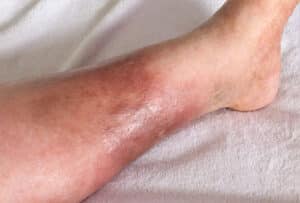
What is DVT?
DVT, deep vein thrombosis, occurs when blood pools and clots in a vein that is deep beneath the skin. In superficial veins, we refer to this pooling as varicose veins. Deep vein thrombosis is different because we cannot see it. A clot may form in a leg and restrict blood flow to other areas. More concerning, the DVT clot can break loose at some point and enter the lungs, where it can create an emergency medical event called pulmonary embolism. The Centers for Disease Control and Prevention claims that nearly half of DVT cases progress to pulmonary embolism. This is alarming but, on the other hand, armed with information, we can reduce the risks of DVT with simple steps. One of the tricky things about DVT, and why people feel unsettled about it, is that it often occurs without any indication. The signs of a blood clot may include restless leg syndrome or “twitchy” legs when resting or trying to sleep. The legs may feel fatigued or achy. More prominent symptoms include swelling, skin discoloration near the clot, and skin that is warm to the touch at the site of the clot.
Prevention and Treatment
Adults of all ages are encouraged to know their family medical history for vascular and vein conditions as a way to better know their own risks for conditions like deep vein thrombosis. This knowledge, as well as awareness of other risks, such as smoking and obesity, can guide preventative steps. Like other vascular and vein conditions, the risk of DVT may be managed with regular exercise, especially walking and other activities that strengthen the lower legs. Sitting for long periods is detrimental to vein health, so doctors encourage patients to stand up and move around for about five minutes every hour or so. Regular physical examinations that include blood work to measure cholesterol levels may also be beneficial to the prevention of venous insufficiency, a primary risk factor for DVT.
The treatments that are commonly prescribed for deep vein thrombosis are very conservative. The goal of medical intervention is to prevent the clot from growing, or possibly to decrease the clot so it can be absorbed. In more severe cases, a minor surgical procedure may be needed to remove the clot. At Vascular Institute of Virginia, patients can expect professional diagnostic and therapeutic care in a friendly environment. To schedule a visit at our Fredericksburg, Woodbridge, or Fairfax, VA location, contact us at 703-763-5224.

